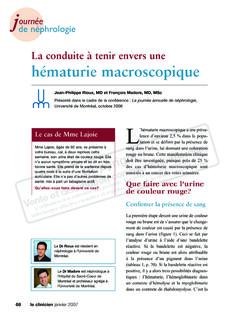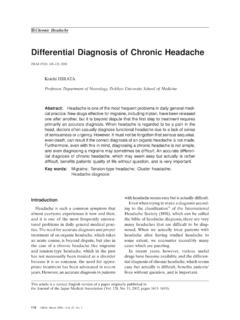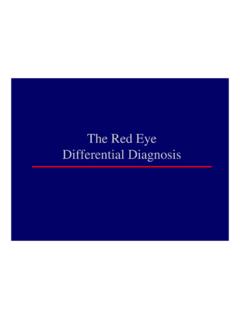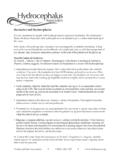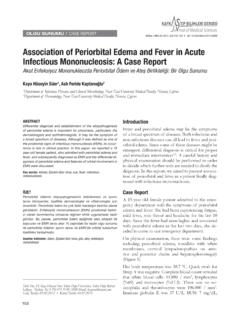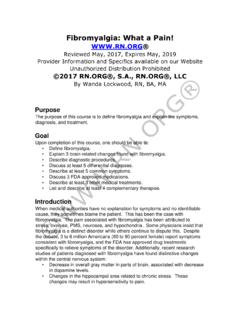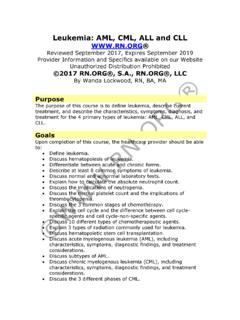Transcription of UNDERSTANDING Tremor in the Elderly
1 The Canadian Journal of diagnosis / April 200199 UNDERSTANDINGT remor inthe ElderlyBy Joel Hurwitz, MB, FRCPC, FCPT remor is an important and frequent symptom/sign in olderpatients requiring a logical approach to diagnosis . The clinicianshould know the different types of common tremors, keyquestions to ask, practical office examination skills, specific drugtreatments, when to refer the patient for a specialist opinion andthe possible role of andCharacteristics of TremorTremor is defined as a rhythmic, oscillatorytype of involuntary movement. When foundin the Elderly , it needs to be distinguishedfrom: Dystonia (sustained involuntary con-traction); Chorea (rapid, random flowing move-ments); Myoclonus (rapid jerking movements); Akasthisia (subjective state of motorrestlessness usually a consequence ofneuroleptic exposure); and Tardive dyskinesia (mouth, tongue andchewing movements associated with atleast three months of neurolepticexposure).
2 Tremor amplitude may be classified asfine, medium or coarse and Tremor frequen-cy can be divided into three categories ofoscillations per second: Slow (3 Hz to 5 Hz); Intermediate (5 Hz to 8 Hz); and Rapid (9 Hz to 12 Hz).Categories of TremorAttention to two factors is critical for cor-rectly categorizing Tremor (see Table 1): When is the Tremor present ( at rest,100 Tremor IN THEELDERLYThe Canadian Journal of diagnosis / April 2001with posture or with action)? Which parts of the body are affected( hands, head, tongue, chin, etc.)?Rest Tremor This Tremor , typical ofparkinsonism, has a frequency of 4 Hz to 6Hz, a coarse amplitude and is classicallyreferred to as the pill rolling Tremor of thehands.
3 It is best observed when the hands areresting on the patient s lap, but also is con-sistently seen during walking. This Tremor ischaracteristically worse with anxiety (askthe patient to subtract sevens serially from100 or say the months of the year in reverseorder) and is usually absent during Tremor occurs less commonly in thechin and the Tremor The name implies thatthe Tremor is present when the body part ispositioned against gravity. This Tremor ,typical of essential Tremor (ET), has a fre-quency of 5 Hz to 9 Hz and an amplitudethat varies with different postures.
4 It may,for example, be mild when hands are heldextended in front, but is often most markedwhen the patient holds a cup close to themouth. Head Tremor (most frequently seen inET) is also a postural type ET classically presents in middleage, older persons often develop a late onsetor senile variant of ET which may be mis-taken for a parkinsonian Tremor . Althoughother parkinsonian features are absent inET, a postural action Tremor that is indistin-guishable from ET may precede, by severalRest Tremor Parkinson s disease. Other Parkinsonian syndromes (see Table 2).
5 Postural Tremor Essential Tremor . Exaggerated physiological ,anxiety, fatigue ie., , - bronchodilators (eg. salbutamol andaminophylline) lithium, tricyclicantidepressants, selective serotoninreuptake inhibitors (SSRIs), decongestants(eg. pseudoephedrine andphenylpropanolamine) neuroleptics,amphetamines (eg. methylphenidate),dopamine agonists, valproic abuse - chronic alcohol use/withdrawal,excess caffeine, benzodiazepine Tremor Cerebellar disease eg., multiple sclerosis cerebellarinfarcts and tumors, (cerebellar atrophy secondary toethanol more often associated with a gait ataxia).
6 Miscellaneous Orthostatic Tremor . Psychogenic Tremor . Asterixis. 1 CLASSIFICATION OF DIFFERENTIALDIAGNOSIS OF TREMORSDr. Hurwitz is associateprofessor, division of geriatricmedicine, University ofWestern Ontario and medicaldirector, Southwestern OntarioRegional Geriatric AssessmentUnit, St. Joseph s HealthCare, London , the development of Parkinson s disease (PD) insome patients. Elderly patients with apparent essentialtremor should be closely watched for emergence ofsymptoms and signs of Tremor This Tremor is typical of cerebellar diseaseand, as the name implies, the Tremor is present when theaffected body part is moving.
7 The Tremor characteristicallyhas a frequency of 3 Hz to 10 Hz and is demonstrated by fin-ger-nose or heel-shin testing. Specific tasks, such as hand-writing or pouring water may further bring out an actiontremor. Although the usual parkinsonian rest Tremor mayhave a postural component, it is usually absent during Questions to Ask Your PatientsRegarding Tremor Ask them to describe those situations where Tremor ismost evident. For example, essential Tremor andother postural tremors are typically worse when try-ing to drink from a glass or spoon, or when carryinga cup.
8 Conversely, alcohol usually ameliorates thistype of Tremor . Enquire regarding other neurological symptoms suchas slowing of gait, difficulty with fine motor func-tions (like doing shirt buttons) or changes in hand-writing (micrographia). These are all features of PD. Obtain a thorough medication history, including bothprescribed and over-the-counter preparations. Alwaysask about caffeine, alcohol and other lifestyle sub-stances. Ask about family history although ET occurs spo-radically it is often inherited. There is a positive fami-ly history in at least 50% of all cases and the genetictransmission seems to be autosomal dominant withvariable penetrance.
9 Conversely, PD usually occurssporadically, although persons with a first-degree rel-ative (mother, father, brother, sister or child) with PDare at three times greater risk for the disease. Ask how alcohol affects the Tremor . About 50% ofpatients with ET notice improvement after consumingalcohol. Cerebellar Tremor typically worsens. Alcoholabuse and withdrawal also may cause Tremor . Tremor IN THEELDERLYKey Physical Examination PointsRegarding Tremor Take a hand-writing sample. (SeeFigures 1 and 2)- Patients with PD have micrographia(script becomes progressively smallerand falls below the line).
10 - Patients with ET have shaky but nor-mal sized script. Look for goiter and signs of hyperthy-roidism. Do an emotional IN THEELDERLYThe Canadian Journal of diagnosis / April 2001 Figure patient has PD. October 1999 is before treatment with levodopa was started and February 2000 is afterlevodopa treatment. Both swirls on the right hand side are small and characteristic of PD. Hand-writing samples showmicrographia but the second, post-treatment sample is somewhat patient has severe essential Tremor with significant voice and limb involvement. The figure containsscript that reads This is a sample of my best hand-writing and, on the right side, the patient's attempt to copy theassessor s that agitation is a common presentationof an underlying depression in the older patient andmay also be an early manifestation of dementia.






